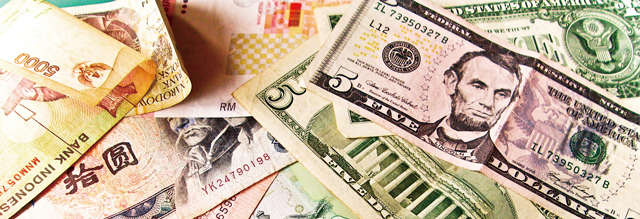 The exchange rate is the value of one currency expressed in terms of another country's currency. For example, in June 2011, 80 yen would buy one U.S. dollar, or, expressed another way, one Japanese yen would buy 0.0124 U.S. dollars. Forex, short for “foreign exchange,” is the buying and selling of foreign currencies. Currency traders exchange one currency for another in order to exploit different values of the currencies. These values fluctuate according to a number of factors. Currencies can be traded at spot and foreign exchange options markets. The spot market represents current exchange rates, whereas options are derivatives of exchange rates. An increase in transaction demand will drive up the cost of buying a currency. In times of strong economic growth, the demand for the use of currency in normal business transactions increases, and the value of the currency appreciates. Similarly an increase in speculative demand for a currency will drive up its cost. In other words, more of this currency is being bought as a speculation by currency traders because the value of this currency is expected to rise in the future. The higher a country's interest rates, the greater the demand for that currency. Most major currencies are said to be free-floating; that is, their exchange rates are allowed to vary against those of other currencies. Other currencies are “pegged,” or the exchange rate is fixed to another country's currency(historically, the U.S. dollar). There are a handful of different ways of measuring exchange rates. A bilateral exchange rate involves a currency pair. A nominal effect exchange rate(NEER) is the unadjusted weighted average value of one country's currency relative to a group of other traded currencies. A real effective exchange rate(REER) adjusts NEER by appropriate foreign price level and deflates by the home country price level. Anyone wishing to engage in forex must be aware of the extent to which the cross-border trading of financial assets (stocks and bonds) drives currency fluctuations. The proportion of such foreign exchange transactions now dwarfs the extent of currency transactions generated from trading in goods and services. 匯率係指一國貨幣的價值以他國貨幣呈現。舉例來說,在2011 年6月,1 塊美金等值80日圓,或反過來說,即1日圓值0.0124塊美元。Forex(foreign exchange,外匯縮寫)指外國貨幣的買賣。外匯交易員透過不同幣別間的轉換來賺取價差,而各幣別價值波動則受多重因素影響。 Forex(foreign exchange,外匯縮寫)指外國貨幣的買賣。外匯交易員透過不同幣別間的轉換來賺取價差,而各幣別價值波動則受多重因素影響。 貨幣可在現貨市場,或是外匯選擇權市場交易。現貨市場價格為貨幣當下的匯率,選擇權則是以匯率為標的的衍生性金融商品。 交易需求的增加,將使得購買某幣別的交易成本上升。在經濟強勁成長時,一般企業對貨幣的交易使用需求增加,而這將使得貨幣升值。 同樣地,對貨幣的投機性需求增強,也會使貨幣購買成本上升。也就是說,當預期某貨幣未來將會升值時,該貨幣便會被外匯交易員大筆買進。而當一國的利率越高,市場對該國貨幣的需求亦會越高。 多數主要貨幣是自由浮動的(譯註:浮動匯率制)。也就是說,相對於其他貨幣,它們的匯率是可變動的。其餘貨幣匯率則是被「釘」住的(譯註:固定匯率制),即其與其他國家貨幣之間的匯率是固定的(一般傳統上多以美元做為釘住對象)。 有少數幾種不同方式可用來衡量匯率。「雙邊匯率」係指兩個國家貨幣間的交換比率。而「名目有效匯率」(NEER)則是就一國貨幣相對於一籃子的各種外國貨幣間之名目匯率,尚未調整前予以加權平均。「實質有效匯率」(REER)則是將「名目有效匯率」以適當的外國物價水準來做調整,並以本國物價指數平減之。 任何想從事外匯操作的人,都必須瞭解金融資產(股票與債券)之跨境交易,對匯率變動的影響程度。傳統商品、勞務相關的匯率交易規模,與此相比,已是相形見拙。 |
沒有留言:
張貼留言